Jie Feng
CityRiSE: Reasoning Urban Socio-Economic Status in Vision-Language Models via Reinforcement Learning
Oct 25, 2025Abstract:Harnessing publicly available, large-scale web data, such as street view and satellite imagery, urban socio-economic sensing is of paramount importance for achieving global sustainable development goals. With the emergence of Large Vision-Language Models (LVLMs), new opportunities have arisen to solve this task by treating it as a multi-modal perception and understanding problem. However, recent studies reveal that LVLMs still struggle with accurate and interpretable socio-economic predictions from visual data. To address these limitations and maximize the potential of LVLMs, we introduce \textbf{CityRiSE}, a novel framework for \textbf{R}eason\textbf{i}ng urban \textbf{S}ocio-\textbf{E}conomic status in LVLMs through pure reinforcement learning (RL). With carefully curated multi-modal data and verifiable reward design, our approach guides the LVLM to focus on semantically meaningful visual cues, enabling structured and goal-oriented reasoning for generalist socio-economic status prediction. Experiments demonstrate that CityRiSE with emergent reasoning process significantly outperforms existing baselines, improving both prediction accuracy and generalization across diverse urban contexts, particularly for prediction on unseen cities and unseen indicators. This work highlights the promise of combining RL and LVLMs for interpretable and generalist urban socio-economic sensing.
AutoQual: An LLM Agent for Automated Discovery of Interpretable Features for Review Quality Assessment
Oct 09, 2025
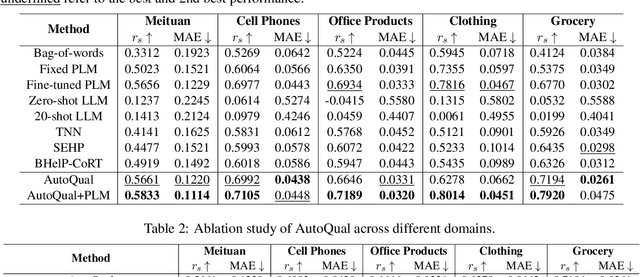
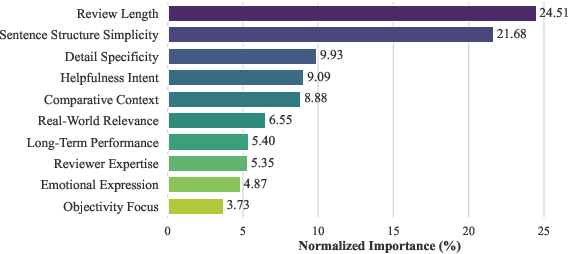
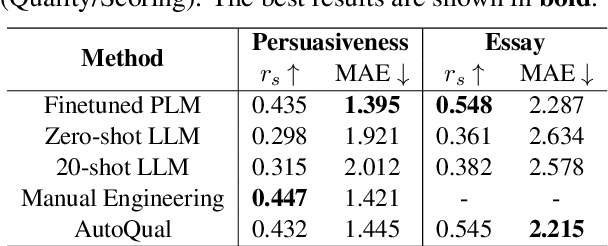
Abstract:Ranking online reviews by their intrinsic quality is a critical task for e-commerce platforms and information services, impacting user experience and business outcomes. However, quality is a domain-dependent and dynamic concept, making its assessment a formidable challenge. Traditional methods relying on hand-crafted features are unscalable across domains and fail to adapt to evolving content patterns, while modern deep learning approaches often produce black-box models that lack interpretability and may prioritize semantics over quality. To address these challenges, we propose AutoQual, an LLM-based agent framework that automates the discovery of interpretable features. While demonstrated on review quality assessment, AutoQual is designed as a general framework for transforming tacit knowledge embedded in data into explicit, computable features. It mimics a human research process, iteratively generating feature hypotheses through reflection, operationalizing them via autonomous tool implementation, and accumulating experience in a persistent memory. We deploy our method on a large-scale online platform with a billion-level user base. Large-scale A/B testing confirms its effectiveness, increasing average reviews viewed per user by 0.79% and the conversion rate of review readers by 0.27%.
MoveFM-R: Advancing Mobility Foundation Models via Language-driven Semantic Reasoning
Sep 26, 2025Abstract:Mobility Foundation Models (MFMs) have advanced the modeling of human movement patterns, yet they face a ceiling due to limitations in data scale and semantic understanding. While Large Language Models (LLMs) offer powerful semantic reasoning, they lack the innate understanding of spatio-temporal statistics required for generating physically plausible mobility trajectories. To address these gaps, we propose MoveFM-R, a novel framework that unlocks the full potential of mobility foundation models by leveraging language-driven semantic reasoning capabilities. It tackles two key challenges: the vocabulary mismatch between continuous geographic coordinates and discrete language tokens, and the representation gap between the latent vectors of MFMs and the semantic world of LLMs. MoveFM-R is built on three core innovations: a semantically enhanced location encoding to bridge the geography-language gap, a progressive curriculum to align the LLM's reasoning with mobility patterns, and an interactive self-reflection mechanism for conditional trajectory generation. Extensive experiments demonstrate that MoveFM-R significantly outperforms existing MFM-based and LLM-based baselines. It also shows robust generalization in zero-shot settings and excels at generating realistic trajectories from natural language instructions. By synthesizing the statistical power of MFMs with the deep semantic understanding of LLMs, MoveFM-R pioneers a new paradigm that enables a more comprehensive, interpretable, and powerful modeling of human mobility. The implementation of MoveFM-R is available online at https://anonymous.4open.science/r/MoveFM-R-CDE7/.
Vision-G1: Towards General Vision Language Reasoning with Multi-Domain Data Curation
Aug 18, 2025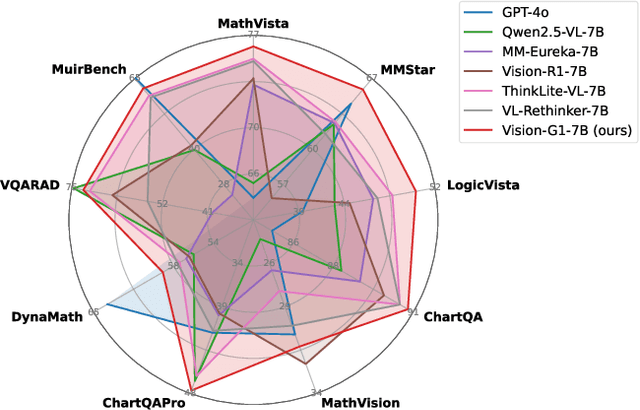
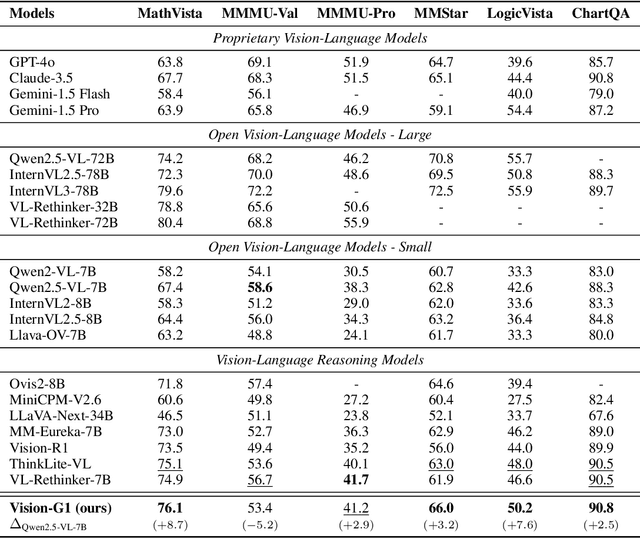

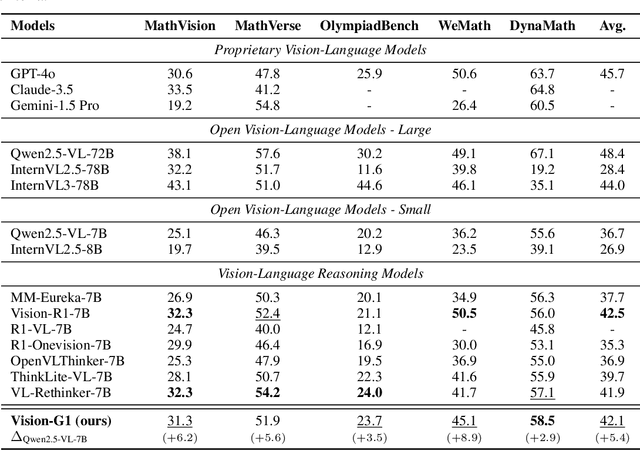
Abstract:Despite their success, current training pipelines for reasoning VLMs focus on a limited range of tasks, such as mathematical and logical reasoning. As a result, these models face difficulties in generalizing their reasoning capabilities to a wide range of domains, primarily due to the scarcity of readily available and verifiable reward data beyond these narrowly defined areas. Moreover, integrating data from multiple domains is challenging, as the compatibility between domain-specific datasets remains uncertain. To address these limitations, we build a comprehensive RL-ready visual reasoning dataset from 46 data sources across 8 dimensions, covering a wide range of tasks such as infographic, mathematical, spatial, cross-image, graphic user interface, medical, common sense and general science. We propose an influence function based data selection and difficulty based filtering strategy to identify high-quality training samples from this dataset. Subsequently, we train the VLM, referred to as Vision-G1, using multi-round RL with a data curriculum to iteratively improve its visual reasoning capabilities. Our model achieves state-of-the-art performance across various visual reasoning benchmarks, outperforming similar-sized VLMs and even proprietary models like GPT-4o and Gemini-1.5 Flash. The model, code and dataset are publicly available at https://github.com/yuh-zha/Vision-G1.
AMFT: Aligning LLM Reasoners by Meta-Learning the Optimal Imitation-Exploration Balance
Aug 12, 2025Abstract:Large Language Models (LLMs) are typically fine-tuned for reasoning tasks through a two-stage pipeline of Supervised Fine-Tuning (SFT) followed by Reinforcement Learning (RL), a process fraught with catastrophic forgetting and suboptimal trade-offs between imitation and exploration. Recent single-stage methods attempt to unify SFT and RL using heuristics, but lack a principled mechanism for dynamically balancing the two paradigms. In this paper, we reframe this challenge through the theoretical lens of \textbf{implicit rewards}, viewing SFT and RL not as distinct methods but as complementary reward signals. We introduce \textbf{Adaptive Meta Fine-Tuning (AMFT)}, a novel single-stage algorithm that learns the optimal balance between SFT's implicit, path-level reward and RL's explicit, outcome-based reward. The core of AMFT is a \textbf{meta-gradient adaptive weight controller} that treats the SFT-RL balance as a learnable parameter, dynamically optimizing it to maximize long-term task performance. This forward-looking approach, regularized by policy entropy for stability, autonomously discovers an effective training curriculum. We conduct a comprehensive evaluation on challenging benchmarks spanning mathematical reasoning, abstract visual reasoning (General Points), and vision-language navigation (V-IRL). AMFT consistently establishes a new state-of-the-art and demonstrats superior generalization on out-of-distribution (OOD) tasks. Ablation studies and training dynamic analysis confirm that the meta-learning controller is crucial for AMFT's stability, sample efficiency, and performance, offering a more principled and effective paradigm for LLM alignment. Our codes are open-sourced via https://github.com/hlxtsyj/AMFT.
UniMove: A Unified Model for Multi-city Human Mobility Prediction
Aug 09, 2025Abstract:Human mobility prediction is vital for urban planning, transportation optimization, and personalized services. However, the inherent randomness, non-uniform time intervals, and complex patterns of human mobility, compounded by the heterogeneity introduced by varying city structures, infrastructure, and population densities, present significant challenges in modeling. Existing solutions often require training separate models for each city due to distinct spatial representations and geographic coverage. In this paper, we propose UniMove, a unified model for multi-city human mobility prediction, addressing two challenges: (1) constructing universal spatial representations for effective token sharing across cities, and (2) modeling heterogeneous mobility patterns from varying city characteristics. We propose a trajectory-location dual-tower architecture, with a location tower for universal spatial encoding and a trajectory tower for sequential mobility modeling. We also design MoE Transformer blocks to adaptively select experts to handle diverse movement patterns. Extensive experiments across multiple datasets from diverse cities demonstrate that UniMove truly embodies the essence of a unified model. By enabling joint training on multi-city data with mutual data enhancement, it significantly improves mobility prediction accuracy by over 10.2\%. UniMove represents a key advancement toward realizing a true foundational model with a unified architecture for human mobility. We release the implementation at https://github.com/tsinghua-fib-lab/UniMove/.
SeqAffordSplat: Scene-level Sequential Affordance Reasoning on 3D Gaussian Splatting
Jul 31, 2025Abstract:3D affordance reasoning, the task of associating human instructions with the functional regions of 3D objects, is a critical capability for embodied agents. Current methods based on 3D Gaussian Splatting (3DGS) are fundamentally limited to single-object, single-step interactions, a paradigm that falls short of addressing the long-horizon, multi-object tasks required for complex real-world applications. To bridge this gap, we introduce the novel task of Sequential 3D Gaussian Affordance Reasoning and establish SeqAffordSplat, a large-scale benchmark featuring 1800+ scenes to support research on long-horizon affordance understanding in complex 3DGS environments. We then propose SeqSplatNet, an end-to-end framework that directly maps an instruction to a sequence of 3D affordance masks. SeqSplatNet employs a large language model that autoregressively generates text interleaved with special segmentation tokens, guiding a conditional decoder to produce the corresponding 3D mask. To handle complex scene geometry, we introduce a pre-training strategy, Conditional Geometric Reconstruction, where the model learns to reconstruct complete affordance region masks from known geometric observations, thereby building a robust geometric prior. Furthermore, to resolve semantic ambiguities, we design a feature injection mechanism that lifts rich semantic features from 2D Vision Foundation Models (VFM) and fuses them into the 3D decoder at multiple scales. Extensive experiments demonstrate that our method sets a new state-of-the-art on our challenging benchmark, effectively advancing affordance reasoning from single-step interactions to complex, sequential tasks at the scene level.
Mem4Nav: Boosting Vision-and-Language Navigation in Urban Environments with a Hierarchical Spatial-Cognition Long-Short Memory System
Jun 24, 2025Abstract:Vision-and-Language Navigation (VLN) in large-scale urban environments requires embodied agents to ground linguistic instructions in complex scenes and recall relevant experiences over extended time horizons. Prior modular pipelines offer interpretability but lack unified memory, while end-to-end (M)LLM agents excel at fusing vision and language yet remain constrained by fixed context windows and implicit spatial reasoning. We introduce \textbf{Mem4Nav}, a hierarchical spatial-cognition long-short memory system that can augment any VLN backbone. Mem4Nav fuses a sparse octree for fine-grained voxel indexing with a semantic topology graph for high-level landmark connectivity, storing both in trainable memory tokens embedded via a reversible Transformer. Long-term memory (LTM) compresses and retains historical observations at both octree and graph nodes, while short-term memory (STM) caches recent multimodal entries in relative coordinates for real-time obstacle avoidance and local planning. At each step, STM retrieval sharply prunes dynamic context, and, when deeper history is needed, LTM tokens are decoded losslessly to reconstruct past embeddings. Evaluated on Touchdown and Map2Seq across three backbones (modular, state-of-the-art VLN with prompt-based LLM, and state-of-the-art VLN with strided-attention MLLM), Mem4Nav yields 7-13 pp gains in Task Completion, sufficient SPD reduction, and >10 pp nDTW improvement. Ablations confirm the indispensability of both the hierarchical map and dual memory modules. Our codes are open-sourced via https://github.com/tsinghua-fib-lab/Mem4Nav.
CAMS: A CityGPT-Powered Agentic Framework for Urban Human Mobility Simulation
Jun 16, 2025Abstract:Human mobility simulation plays a crucial role in various real-world applications. Recently, to address the limitations of traditional data-driven approaches, researchers have explored leveraging the commonsense knowledge and reasoning capabilities of large language models (LLMs) to accelerate human mobility simulation. However, these methods suffer from several critical shortcomings, including inadequate modeling of urban spaces and poor integration with both individual mobility patterns and collective mobility distributions. To address these challenges, we propose \textbf{C}ityGPT-Powered \textbf{A}gentic framework for \textbf{M}obility \textbf{S}imulation (\textbf{CAMS}), an agentic framework that leverages the language based urban foundation model to simulate human mobility in urban space. \textbf{CAMS} comprises three core modules, including MobExtractor to extract template mobility patterns and synthesize new ones based on user profiles, GeoGenerator to generate anchor points considering collective knowledge and generate candidate urban geospatial knowledge using an enhanced version of CityGPT, TrajEnhancer to retrieve spatial knowledge based on mobility patterns and generate trajectories with real trajectory preference alignment via DPO. Experiments on real-world datasets show that \textbf{CAMS} achieves superior performance without relying on externally provided geospatial information. Moreover, by holistically modeling both individual mobility patterns and collective mobility constraints, \textbf{CAMS} generates more realistic and plausible trajectories. In general, \textbf{CAMS} establishes a new paradigm that integrates the agentic framework with urban-knowledgeable LLMs for human mobility simulation.
Breaking Data Silos: Towards Open and Scalable Mobility Foundation Models via Generative Continual Learning
Jun 07, 2025Abstract:Foundation models have revolutionized fields such as natural language processing and computer vision by enabling general-purpose learning across diverse tasks and datasets. However, building analogous models for human mobility remains challenging due to the privacy-sensitive nature of mobility data and the resulting data silos across institutions. To bridge this gap, we propose MoveGCL, a scalable and privacy-preserving framework for training mobility foundation models via generative continual learning. Without sharing raw data, MoveGCL enables decentralized and progressive model evolution by replaying synthetic trajectories generated from a frozen teacher model, and reinforces knowledge retention through a tailored distillation strategy that mitigates catastrophic forgetting. To address the heterogeneity of mobility patterns, MoveGCL incorporates a Mixture-of-Experts Transformer with a mobility-aware expert routing mechanism, and employs a layer-wise progressive adaptation strategy to stabilize continual updates. Experiments on six real-world urban datasets demonstrate that MoveGCL achieves performance comparable to joint training and significantly outperforms federated learning baselines, while offering strong privacy protection. MoveGCL marks a crucial step toward unlocking foundation models for mobility, offering a practical blueprint for open, scalable, and privacy-preserving model development in the era of foundation models.
 Add to Chrome
Add to Chrome Add to Firefox
Add to Firefox Add to Edge
Add to Edge